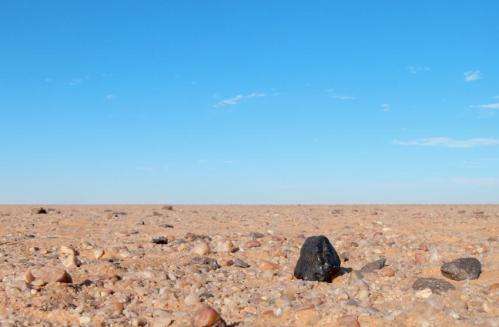August 21, 2014 report
Meteorite study indicates volcanic activity on early small asteroids

(Phys.org) —Examination of one of the Almahata Sitta meteorites (aka, ALM-A, found in Sudan in 2008) by a team of space scientists working in Germany has revealed a volcanic past. In their paper published in Proceedings of the National Academy of Sciences, the team describes how they dated the meteorite to just a few million years after our solar system was born and uncovered evidence that it suggests it was produced by volcanic activity.
The meteorite is but one of a collection that came from 2008 TC3, the first asteroid to ever have its collision with Earth tracked by scientists. When it exploded over the Nubian Desert, debris was scattered over many kilometers—over 600 meteorites from it have been found thus far. In this latest effort, the researchers focused on ALM-A, studying it using optical and electron microscopy—they found the rock contained minerals that were rich in a kind of silica that to date has been found to only be producible by certain types of explosions or volcanic action.
The rapid crystallization, the researchers claim, could only have come about due to an explosion (not the kind that happens when an asteroid enters an atmosphere) or because of the sort of rapid cooling that occurs when extremely hot lava seeps out of the ground. Because it is unlikely that conditions would have ever existed on the asteroid that could have led to the type of explosion capable of producing such crystallized silica, the only option is that the asteroid from which the meteorite came, had at least one volcano on it, at some point. If so, that would mean that volcanic activity existed in our solar system much earlier than scientists have thought.
But that's not the whole story, the researchers believe the asteroid that broke apart when it collided with Earth's atmosphere was part of a different asteroid that was nearly destroyed close to six and a half million years ago when it collided with another asteroid. After that there were likely other collisions, some of which resulted in melding with other asteroids, which would explain the uniqueness of the Almahata Sitta meteorites—they host a variety of minerals not ordinarily found on just one specimen.
More information: Trachyandesitic volcanism in the early Solar System, Addi Bischoff, PNAS, DOI: 10.1073/pnas.1404799111
Abstract
Volcanism is a substantial process during crustal growth on planetary bodies and well documented to have occurred in the early Solar System from the recognition of numerous basaltic meteorites. Considering the ureilite parent body (UPB), the compositions of magmas that formed a potential UPB crust and were complementary to the ultramafic ureilite mantle rocks are poorly constrained. Among the Almahata Sitta meteorites, a unique trachyandesite lava (with an oxygen isotope composition identical to that of common ureilites) documents the presence of volatile- and SiO2-rich magmas on the UPB. The magma was extracted at low degrees of disequilibrium partial melting of the UPB mantle. This trachyandesite extends the range of known ancient volcanic, crust-forming rocks and documents that volcanic rocks, similar in composition to trachyandesites on Earth, also formed on small planetary bodies ∼4.56 billion years ago. It also extends the volcanic activity on the UPB by ∼1 million years (Ma) and thus constrains the time of disruption of the body to later than 6.5 Ma after the formation of Ca–Al-rich inclusions.
Journal information: Proceedings of the National Academy of Sciences
© 2014 Phys.org





















